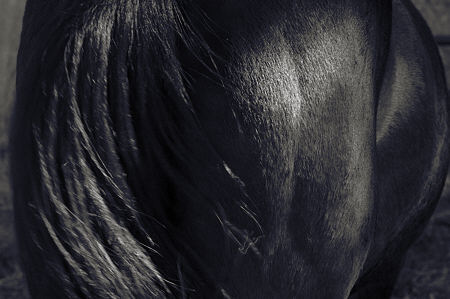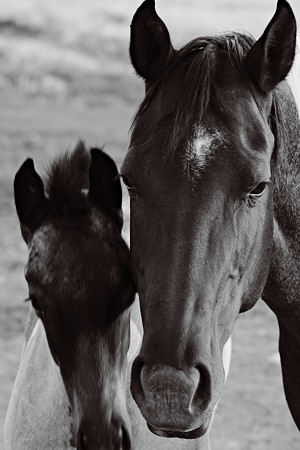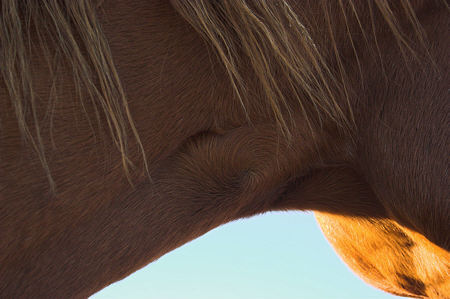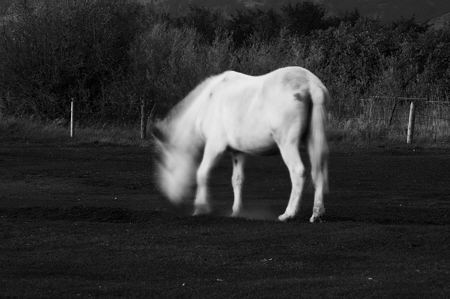I’ve been continuing with my new project on horses, which has predictably wandered into a thicket of possibilities. I’m confident it will emerge at some point — though I daren’t say when — and when it does, it will necessarily be in some direction or other. Hopefully trailing a series with some coherence.

But at the moment, I’m taking many different kinds of pictures. The very few I’ve put on my web site are a motley and incomplete assortment, determined more by (lack of) time available than anything else. The experience has me thinking about the nature of projects.
Looking at the images afterwards, I can loosely place most of them into a few categories. First are the abstracts, like the one above, which are closest to the original idea stimulated, as described, by some work of Kathe Lesage. Most of these I have handled in my usual toned black and white, but some seem to be interesting with over-saturation of the color, akin to what I’m doing with weathered surfaces in my Patina project, though these colors are darker and less dramatic.

Then there are the portraits, of which the one below is perhaps the most conventional. This is becoming more fun as I get to know the horses individually. I’m not normally trying specifically to capture a portrait, but sometimes they come out that way. Actually, it’s hard to say what precisely constitutes a portrait, something Richard is perhaps also thinking about. I guess my vague working definition is that it should convey something of the personality of the subject(s).

Next come landscapes, i.e. horses as landscape, forms you could imagine traveling over or around. Clearly, there’s an appeal to abstraction here. These tend to be hill forms, but the one below reminds me, especially in color, of the sandstone arches in Utah, for example in Arches National Park.

Finally, when I remain after sunset and the light gets dim, I set my shutter speed as slow as possible (around a second) and take pictures like the one below. This fits into one of my very first series, which, for lack of a more original title, I am calling Ghost Horses.

Sometimes lack of a single direction might be a good thing. This is how, for me, the various ideas swirling around in my own head can meld into a concept or approach that will be thoroughly my own. Not that this work with horses needs to be a single project. Perhaps the different strands I’ve identified will be separable enough as to constitute separate portfolios. Even so, they’ll inevitably inform each other.
Does this evolution of a project sound familiar to you? Or do ideas come to you with such clarity that it only remains to execute them? Perhaps they come in seeming clarity, as in a dream, only to dissolve when you try to express them? And then begins the effort of re-discovery and re-creation?

Steve, I’d have to answer yes to all your questions in the last paragraph regarding the creative process.
You’ve explained here that you are trying out different ideas but I have to wonder if you’re taking on too many ideas at once? Do you think focusing on one idea, like abstract, would improve or take away from your creative vision?
The last photo is haunting.
I love texture, light and shape in one and four.
I am beginning to realize why I only like certain type of abstract art. I get turned on by shape and texture and luminance – and some subtlety. Clifford is too aggressive for me.
“Or do ideas come to you with such clarity that it only remains to execute them”?
Never.
I wish I had that kind of clarity… in thought and action.
But then, that is what separates art from science – sometimes lack of clarity results in further explorations and newer findings…
The fourth picture is fascinating when you explain the connections to Arches.
Tree,
Well, am taking on too many ideas at once if my goal is to complete a project in not too long. But I’m not in a hurry — I’m having fun! — and these different directions arose on their own, so I’m just accepting them as part of the process. Of course, they relate in various ways to other work I’ve done, for example abstraction in landscape that conjures thoughts of animals is closely akin to abstraction of horses that remind of landscape.
It’s not exactly that I’m “taking on” all these separate projects; it’s more like I’m somewhat passively noticing what’s happening and letting it run its course. At some point I’ll consider that I do have the makings of a portfolio or two or three, and then it will jell a bit.
Thanks Steve. I was curious about your creative process. I sometimes find with my writing, I have several ideas, then I have to settle on one to really focus and do well and hope I eventually get back to the others.
Steve:
Your last photograph makes me think that the horse will then raise his head as a centaur.
And photograph four so reminds me of one of the natural arches out in the Four Corners area.
I can see why you would choose to use the term “abstract” to describe some of these images. Another term like “evocative detail” might work too. I say that because the photograph doesn’t so much remove the subject to another level of generalization, but rather suggests the horse through a detail. One might counter that the detail says “horse” while a fuller image might say “a given horse”. But can the parameters of abstraction be taken from a “more horse -less horse” scale?
Tree,
Exactly.
Jay,
You ask about abstraction. I’m actually trying very hard to figure out what that is, and what it is for me. It surely has something to do with the /particular horse/horse in general/indeterminate horsy shape/ continuum, but I don’t think it’s that simple. What I’m more interested in is the allusive power of what the artist has created. You could say a rectangle is an abstract house, but if it doesn’t feel like or remind you of a house when you view the artwork, then it’s really just a specific rectangle.
It seems it should be possible to make something that is both a specific, say, horse, and also alludes strongly to horseness in general and, beyond that, even to things such as landscape, or humans. The ability to elicit those broader associations is what I’m trying to call abstraction, in my private vocabulary.
Of course, one way to do that is to show a smaller detail of the horse which, as you put it, “says horse,” but may also say other things (those other associations) as your mind is in the process of grasping it. For the image to work, those associations should add fittingly to the subject. (This relates to the question of visual indeterminacy discussed before, though Pepperwell’s paintings never resolve.)
I think a really, really good photo of a horse could be similarly evocative, but if it’s not great then you just immediately perceive “a horse” and are not tempted to go beyond that. I figure I’ll be good when I can make a photograph that is specific and abstract at the same time.
Did that make any sense?
“Or do ideas come to you with such clarity that it only remains to execute them”?
Sure. This morning I imagined two reels with cord strung between. One reel has a handle and other not. The cord has a small dot on it representing a lifetime. This I see as our mortal lot, as we end up rolled into the reel with the handle.
Then I thought of the eternity scenario, where both reels have handles. Time here progresses both ways in a two dimensional fashion. Actually, a better construct would be two sets of reels with cords set across each other with a cinched point of intersection representing whatever module it is ours to eventually adopt. So will I manufacture it? Maybe, after I do all the stuff that I imagined yesterday morning.
Jay, you have an amazing mind.
Steve:
It does to the extent of my understanding.
The allusive can be so elusive. A problem when abstracting is a kind of blood/brain barrier – or perhaps better, Brain/brain barrier. What you have in mind in making the image is transmitted via a visual medium, in an effort to get an intended message across to my mind. I decipher the incoming message on my end as is my wont, and perhaps not as you want. A side channel or two is then often employed, like a one-way-pad to help me understand your message as intended. Your image then comes to me in an annotated fashion; a visual, textual, contextual mixtual. This effort may be for naught in the end as all of the ingredients in the enterprise are fraught with imprecision. This kind of discussion goes way back as a part of the Constructivist dialog.
All of that chowder aside, I would point out that a rectangle can be employed to denote a building. I know from personal experience, as I so denoted thousands of times while making maps in my short career as a photogrammetrist.The side channel instructed the map reader to so interpret the rectangles on the sheet.
I just hope that these concerns are not preventing you from making more lovely images.
Steve, in reading your response to Jay (sorry Jay, not the “amazing mind” comment) I can truly appreciate what you’re working on.
The idea of creating abstraction while at the same time anchoring that to something non-abstract in order to say to the viewer, “Hey! Abstraction!.” A rectangle may not remind a person of a house but maybe it would if there was a tree in the composition…or something like that. I feel I’m in over my head here.
It all reminds me of the use of complementary colors in paintings (like van Gogh’s works). Red is red but it really pops when it’s placed against green. Then you know what red means.
Although I can’t help but wonder if at the end of the day artists really want to control others’ thoughts. Heh. (I think I just heard June snort)
I like more-horse, less horse, myself.
If you love horses, as I do, you simply cannot get enough…but I will say that not all horses are beautiful…not like models versus regular people, as there are many people who are not models who are beautiful in many different ways. Horses, on the other hand, have a certain type of confirmation that must be present without otherwise appearing to be somewhat lacking. I think you should take this into consideration. Manes and tails can also be extremely fascinating, plus there are many different breeds of horses that for whatever reason have not been used. I would like to send you a few photos of horses I have owned and shown-several were World Champions (crowned at the Kentucky State fair in Louisville, where the World Championships for Saddle-bred horses is held every August). If you would like to see those photos, please email me. There is also a wonderful book of horses by a supremely talented sculptress,Deborah Butterfield, who uses many different materials, including metal and driftwood to sculpt incredibly accurate, yet slightly idealized horses. Still, I’d love to show you photos of Saddle-breds in action!! Here’s a link to the Butterfield book, though she has others and the same “coffee table book” can be obtained at Amazon, etc.: http://www.rakuten.com/prod/deborah-butterfield/211936803.html?listingId=266284265&s_kwcid=
Thanks and all the best to you! Horse have been a large part of my entire life-can you tell?